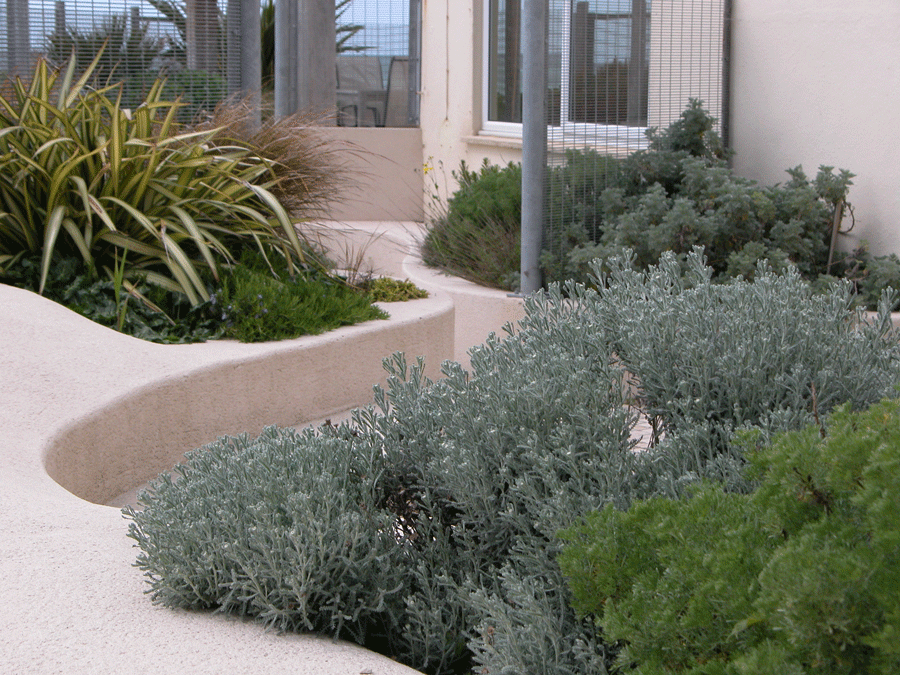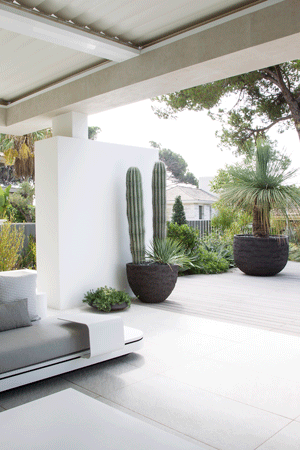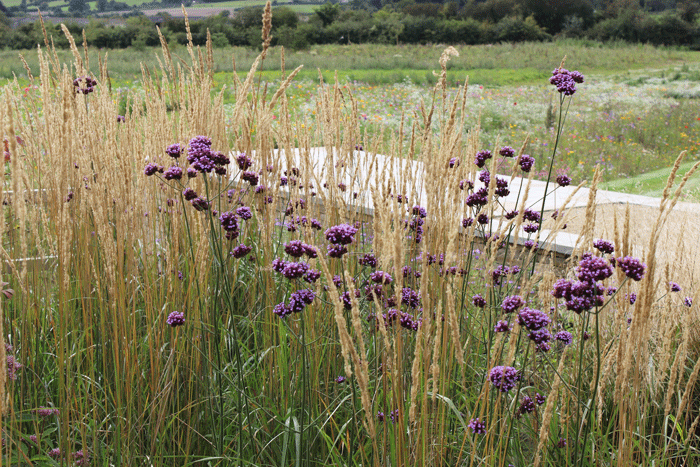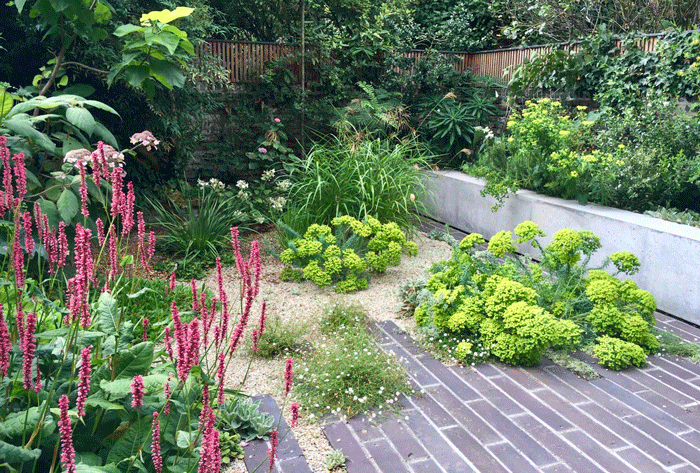Top garden design trends for 2020
 The Society of Garden Designers (SGD) share their predictions for the top garden design trends for 2020.
The Society of Garden Designers (SGD) share their predictions for the top garden design trends for 2020.
As we enter a new decade, what will be the newest trends in garden design? Below, leading designers share their predictions for the newest trends and some of the most exciting design ideas gaining momentum.
Curvilinear Forms – after almost a decade of symmetrically ordered urban gardens, Mark Laurence thinks we’ll see “a turning away from the linear, contemporary town garden to something wilder and more curvilinear.” (pictured banner above). Mark points out that Curvilinear forms appear more natural in a garden environment and they connect us back to the flow of natural forms of landscape. It’s a distinctive move away from the style of crisp, linear raised beds set against horizontal timber trellis that we have become familiar with.
Following a similar path, James Smith of Bowles & Wyer has been experimenting with sculptural wall claddings in wood, metals and stone in organic, naturalistic patterns. He feels wall claddings will gain momentum in 2020 and are perfect for maximising vertical surfaces in tight city gardens.
 Belgian Design – often described as luxurious simplicity is expected to come to the fore in 2020. Mia Witham of Mia Witham Garden Design says: “I am seeing some great garden products coming out of Belgium, which are typically high-end and have great form. I particularly love the beautiful clay pots by Atelier Vierkant, the woven fibre fencing and screens produced by Forest Avenue and the striking garden lights by Wever & Ducre. I’ll be using a lot more of them in 2020.” (pictured left)
Belgian Design – often described as luxurious simplicity is expected to come to the fore in 2020. Mia Witham of Mia Witham Garden Design says: “I am seeing some great garden products coming out of Belgium, which are typically high-end and have great form. I particularly love the beautiful clay pots by Atelier Vierkant, the woven fibre fencing and screens produced by Forest Avenue and the striking garden lights by Wever & Ducre. I’ll be using a lot more of them in 2020.” (pictured left)
Edible Forests and romantic veg plots
With more people using foraged food for cooking Mia Witham thinks that edible forests could become the new vegetable garden. She says: “I’m currently designing an edible forest for a chef in Suffolk. It is carefully designed, semi-wild ecosystem of plants organised in layers with trees making up the canopy layer, shrubs providing a middle layer and perennial plants covering the ground. It’s an exciting concept and unlike a traditional vegetable plot where annual plants are mainly grown, edible forests require minimum input for maximum output.”
Libby Russell MSGD of Mazzullo + Russell agrees with Mia saying that productive gardens are still very much on trend.
Less is more – James Smith MSGD, Design Director at Bowles & Wyer thinks the philosophy of ‘Less is More’ (pictured above) will become more prominent: “I really want to focus on creating more paired back design schemes, but with high attention to detail and finishing.” Also sharing this philosophy, Tracy McQue MSGD of Tracy McQue Gardens is looking forward to planting multiple grasses and a simple palette of perennials to make the lightest of design touches.
Repurpose and recycle
Tracy McQue thinks there will be more of a spotlight on re-purposing of existing materials and recycling garden materials where possible. Mark Laurence MSGD echoes this. His consultancy creates adaptive landscape for a changing world, and as he points out: “repurposed items give a garden an individual look”.
Planting for wildlife
Increasingly, creating sustainable, wildlife-friendly and beautiful spaces needs to be at the forefront of everything we do and it is no surprise that Tracy McQue believes that the materials and plants that we include, where we source them from and how we re-use elements already in the garden are becoming more vital considerations. Sharing in this ideal Jane Brockbank MSGD of Jane Brockbank Gardens points out that people are much more interested in making gardens that are good for wildlife: “Awareness of the climate crisis and the loss of bio-diversity has grown enormously, even over the last year, and we are all taking our gardens far more seriously in regards to the important part they can play.”
Mandy Buckland MSGD of Greencube is incorporating ‘meadow areas, native hedging, gaps in fences for hedgehog movement and of course nectar rich planting‘. Libby Russell points out that our planting is evolving to use many more ‘wild’ plants that are great for bees, birds, pollinators and invertebrates but without losing glamour or impact. She signals single roses, species plants, seed heads and grasses as all being valuable.
Pattern and texture
Jane Brockbank says that pattern and texture will be creeping back into our gardens in 2020: “Cold minimalism is beginning to look pretty tired now,” she says. “And it also begs the question, ‘how does this contribute to the wildlife locally in the garden’?” Jane brings pattern and texture into her designs by creating faceted planting zones and by blurring the lines between the hard landscaped and soft planting areas in the garden. (pictured above)
For those of us who like the outdoor room feel, Mandy Buckland predicts that this trend will live on and will move away from regular formatted paving: “There are lots of outdoor ceramic tiles on the market now. We are installing them as garden ‘rugs’ or design features within landscaped areas to create pattern,” she says.
Render revival
“Look out for Monocouche renders in 2020,” says Mark Laurence. These renders are a rare application in garden design, having been used predominantly by the housebuilding industry. Mark says that Monochouche renders are low maintenance, weather resistant and hard wearing and they have great texture, but they need professional application. A different look can be achieved with conventional render using mineral pigments (which are applied while the render is still green) and layered on in colour washes and absorbed into the surface, keeping the render breathable. Mark thinks the red or yellow ochres tones work very well in garden settings.
Outdoor play
Designers also point out that young families want to encourage their children to get outdoors, prizing them away from laptops etc and Mandy Buckland has been incorporating integrated outdoor play areas in many of the gardens she has been designing in recent months: “We have been incorporating sand pits, hammocks, balance beams and climbing frames and even mini wildlife ponds,” she says.
Wood
Wood has always found a space in our gardens but the next decade may see a new focus on timber. Tracy McQue points out that in the past wood has been viewed as a material to use at ground level or for basic fences but there are many elements in the garden that clever design can incorporate timber into: “We use a local Scottish wood supplier when we can and I love the possibilities it gives us when we’re creating a new garden,” she says.
Mandy Buckland also sees a rise in popularity for charred timber for decking and the use of Shou Sugi Ban – the ancient Japanese wood burning technique.
Cobbles and Contrasts
Libby Russell feels we will be seeing less cut stone in our gardens and more cobbles, pitchers and rough cuts appering on the market, particularly by British suppliers. James Smith, of Bowles & Wyer says he will be pairing highly engineered materials with rough and textured finishes for a lovely contract for their projects in 2020.
The Society of Garden Designers (SGD) has a comprehensive Find a Designer search facility on the SGD website and allows you to search by name, postcode, county or country. For more information please visit: www.sgd.org.uk
Picture credits strictly ©: Banner: Garden by Mark Laurence MSGD; top left: Garden by Mia Witham; middle: ‘Less is More’ garden designed by James Smith MSGD, Bowles & Wyer; Pattern and Texture: The Patterned garden by Jane Brockbank MSGD.



